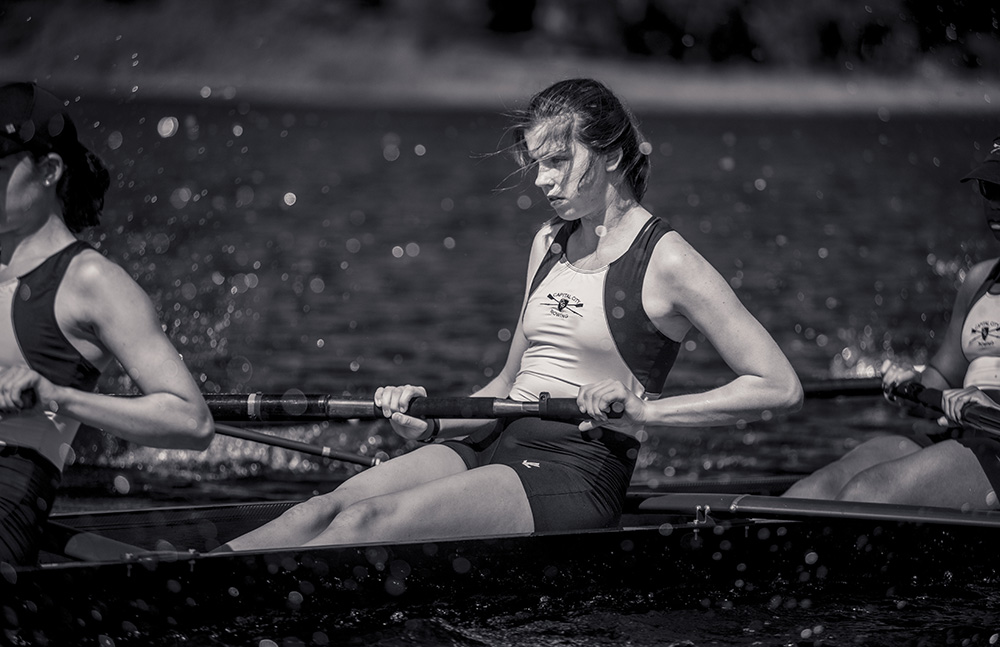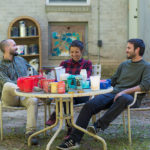by Kristen Coyne | Photography by Dave Barfield
Rowing is a unique and demanding sport
But for Tallahassee youth who love it, it pays generous dividends that make it all worthwhile.
From the vantage point of the eagles cruising above it, Lake Hall resembles the claw of a crab, its pincers poised to clamp down on Thomasville Road to the east. But this small body of water, surrounded by Alfred B. Maclay Gardens State Park and some of Tallahassee’s loveliest homes, feels a world away from that congested six-lane. If you’re lucky enough to find yourself in the middle of it on a spring afternoon, afloat below a lacy film of clouds, it’s like being inside a benign, green embrace.
On most afternoons of the school year, a few dozen teenagers, long, skinny boats hoisted overhead, walk down to the Lake Hall dock, gently lower their shells into the water, and push off into that oasis. Members of Capital City Rowing (CCR), they’ll spend the next few hours on the water building strength and developing skills as rowers. What they take with them: hat, sunglasses, water bottle. What they leave behind: everything else. Relationship stresses, backpacks bulging with homework, even the talismans that are their cell phones: It all remains on shore.
It’s one of the unique things about rowing: when you’re out there on the water, you’re in a kind of zone where parents, problems and even the coaches, to a degree, are kept at bay: It’s just the rowers, their oars, and the job they have to do.
“Your only responsibility while you’re there is to do your best,” said Grant Womble, a rising senior at Chiles High School who has rowed since sixth grade.
“It’s kind of a time when you can just forget about everything else that’s going on and just focus.”
As Grant first learned as a rowing novice after flirtations with baseball, football and soccer, the sport demands a special kind of focus. It also demands time and commitment from its athletes, as well as a small slice of their parents’ paychecks. CCR rowers practice six days a week, returning home ravenous and ripe. Many weekends are consumed by competitions. Their coaches expect promptness, responsibility, maturity.
“What’s interesting about rowing is, you either love it or hate it,” says Kathy Bartlett, a mother of two rowers who sits squarely in the former camp.
For those who catch the skinny boat bug, the sport can be transformative. It can turn a scrawny middle-schooler into a top-notch athlete. It can provide a lonely girl support and community. It can bring structure to the tumultuous teen years and, for a significant percentage of committed rowers, even secure college scholarships.
This story of rowing, however, is not just about individual athletes: After all, no one in the team rows alone. It’s about the individual rowers—usually four or eight to a shell, plus their coxswain—coalescing into a crew. It’s about rowing families, the parents who invest time and money for the opportunities the sport brings their kids. It’s about a community of rowers, coaches and families coming together for regattas, fundraisers and social events.
And of course, it’s about the club itself—a group still small in size but huge in heart. CCR, a community-based youth rowing program founded in 2008, has faced its share of challenges. Most people are unfamiliar with the sport. CCR doesn’t have a boathouse, or even a proper body of water to practice on. Despite its beauty, Lake Hall would need to double in size to accommodate a full 2,000-meter race.
Yet what the team lacks in visibility, geography and amenities it makes up for in talent, commitment and hard work. The team is among the top six in the state, said Head Coach Brett Tillotson, despite being half the size of powerhouse competitors like Sarasota and Winter Park. CCR boats medal consistently in state competitions, and have advanced to nationals every year.
That includes this year. At the Southeast Regionals in May, two CCR boats earned bids to the nationals, slated for June in Sarasota. For both boats, the women’s lightweight four and the women’s eight (both with coxswains, who steers and motivates the rowers), it was the first-ever bid to the country’s biggest youth regatta.
Waiting for them in Sarasota would be some 1,500 athletes from about 150 teams from across the county, most of them much bigger, more established and better funded than CCR. To prepare, CCR’s Sarasota-bound rowers faced several weeks of tough training.
“The competition is like the tip of the iceberg,” said Tillotson, who is also president of the Florida Scholastic Rowing Association. “We’re probably doing 90 to 100 meters of practice for every meter that we race over the course of a year. It’s just a whole lot of preparation we have to do.”
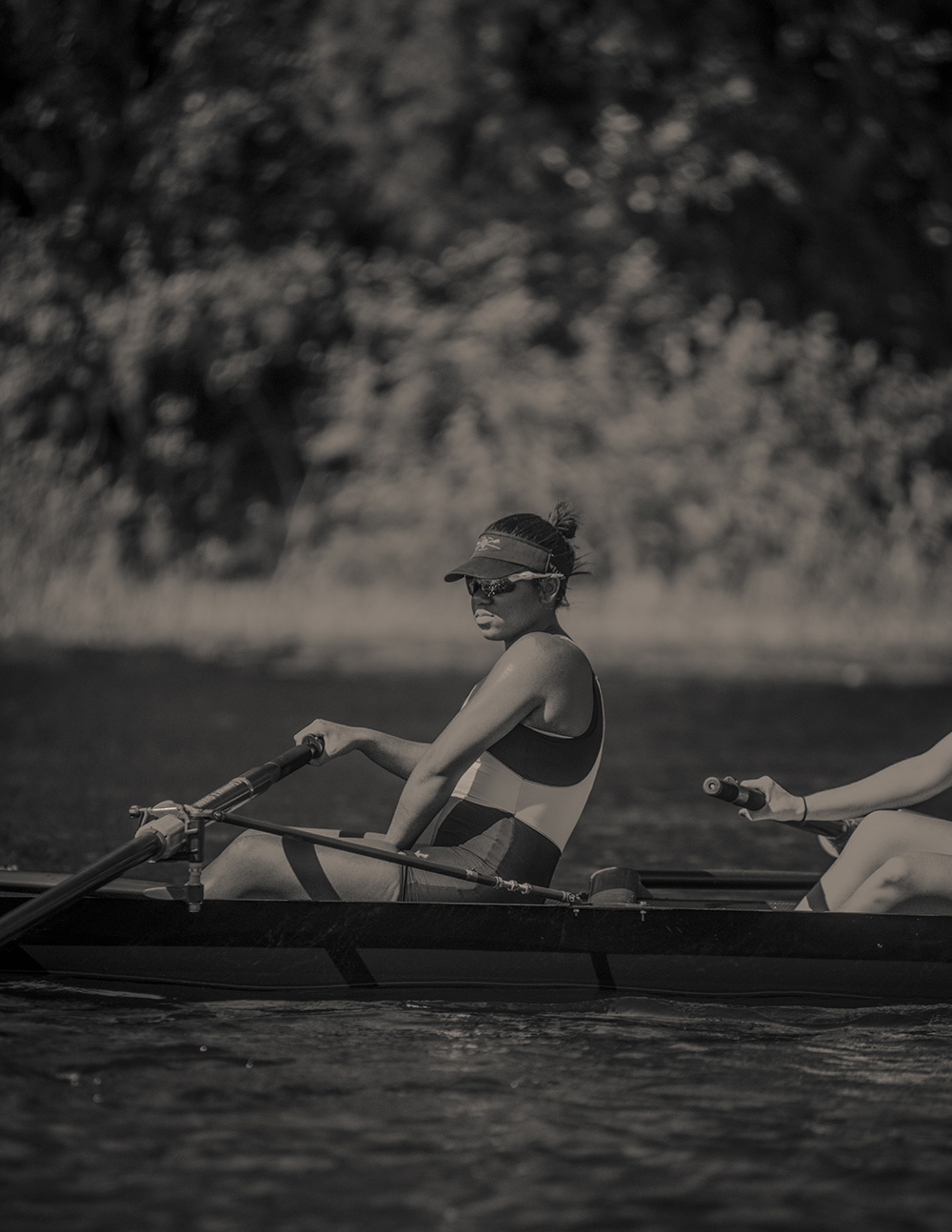
“Let the Boat Glide”
One May afternoon after school, CCR Varsity Women’s Coach JonMichael Francis, armed with a bullhorn, is on Lake Hall with his eight and lightweight four. He wants them working on their starts and on gradually building up speed to a rate of 37 strokes a minute, or about 12 mph.
Francis turns his attention to the eight. The rowers, ponytails sprouting under the required hats and visors, face the stern of their 200-pound, 51-foot-long shell, where cox Emma Shockley faces them at the ready. Some of the girls wear t-shirts from rival rowing clubs in Atlanta, Winter Park and Orlando, the booty of victories earlier in the season.
“You’re not ripping through the water, just increasing speed,” Francis shouts from his motorboat. “Pry the boat open. You’re prying the boat up to speed, OK?”
Then the boats are off, trying to build momentum quickly while still maintaining stability. Per their coxswains’ instructions, rowers adjust their stroke rate. They want speed, want to translate the force of their muscled legs to their carbon fiber oars. Their torsos tilt forward then back, forward then back, oars clicking like a metronome against the oarlocks as they surge ahead.
It looks easy from the shore. Technically and physically, it’s anything but.
Physically, their legs burn with each stroke as the rowers push themselves back on sliding seats to leverage their boat forward. They breathe hard, laboring to oxygenate straining muscles. For novice rowers still adjusting to oar handles, palms are pocked with blisters.
Technically, rowers can spend a lifetime mastering the dozens of tiny movements that go into a stroke: how to angle the oar as it enters and exits the water; how to tilt during the stroke and the recovery; how to grip the handle; how to position their elbows; how close to keep their knees; how to lean, ever so slightly, toward port or starboard in the 1.5-foot wide shell.
It’s all about applying power efficiently. Tillotson describes the perfect stroke.
“The blade is placed into the water at the speed of the boat, and then the rowers’ legs will press down, and the rowers follow through with their bodies,” he said. “Then the blade will come out of the water cleanly, without tearing. You almost have to think of the water as a solid. You lock in, and let the boat glide. Just a very clean application of power without any wasted effort.”
And, oh yeah: The rowers should execute these motions in perfect unison.
After their first 1,000-meter run across Lake Hall, the eight, now dripping with sweat, pass around someone’s t-shirt as a face mop. They all knew it wasn’t a great piece. “That was really hard,” one of the girls told Francis. Their second piece wasn’t much better.
“The stern four, they just really like to press hard, just go,” Francis said later. “Yeah, that’s the right attitude. But you have to remember your power doesn’t always apply that way … You really have to make sure your blade work is as effective as it can be.”
On the afternoon’s last piece, things clicked. And the girls knew it.
“That felt good,” one of the rowers told Francis. “It was powerful,” added another.
The girls had the rhythm, the swing. They were working as one, and it felt strong and right. It was the feeling they chased with every row.
“Yeah, that finish looked good,” Francis concurred. “Pretty solid there, girls.”
Anybody Can Row
The girls and guys of CCR, which draws rowers from all the area middle and high schools, find the sport in different ways. Some test the rowing waters during the Long Skinny Boat Camp the organization runs toward the end of each summer. Some hear about it through friends, a flyer or an email. Often, students discover CCR after competing in other sports they lacked a passion for, burned out on, or just didn’t excel at.
“He really wanted baseball,” remembered Keith Hoogerheyde about his son, Jake, the first of his three children to row for CCR. “He tried so hard, but he just never succeeded.
“Because of that, he was never given any opportunities to grow,” Hoogerheyde continued. “Whereas in rowing, he was forced to be out there and to pull it harder and do it faster and be better—because he was in the boat. You weren’t sitting on the bench watching other people, and you weren’t just there for backup for practice. You were in the boat and you had to move it.”
Not all novice rowers come in as athletes. Ada Ding, a recent Chiles graduate, joined the team as a freshman after getting a taste of the sport at the camp. Her new routine —practice for several hours a day, six days a week—was a shock to her out-of-shape system.
“I would take naps every day after school,” Ding recalled almost wistfully. “To have to go do intense workouts instead— physically and mentally, it was a lot.”
Skinny or chubby, fit or flabby: The team welcomes all novices, said men’s coach Danny Gwynn-Shapiro. Think you’re too tall? Height is an asset in rowing. Afraid you’re too short? That’s great coxswain material. On the slim side? There’s a class for lightweight rowers.
Many sports are virtually off limits to teenagers looking to try something new: To excel in them requires years of practice. But even high school seniors can try rowing for the first time and wind up with college scholarships, as has happened more than once in CCR.
Then there are the kids who seem to have the cards stacked against them. A few years back, recalled head coach Tillotson, a short, slight boy showed up, dressed as if to express his inner turmoil: black t-shirt, jackboots, big ear gauges. He was welcomed, put in the work, set goals, corrected course.
“Four years later,” said Tillotson, “he was rowing for Cornell as a lightweight and winning Eastern Sprints titles.”
Starting from zero? No problem, said Gwynn-Shapiro.
“I think anybody that joins the program and is willing to go through the demands and requirements of all the work that they put in can be successful,” he said. “We can teach anybody to row and we can get anybody in shape.”
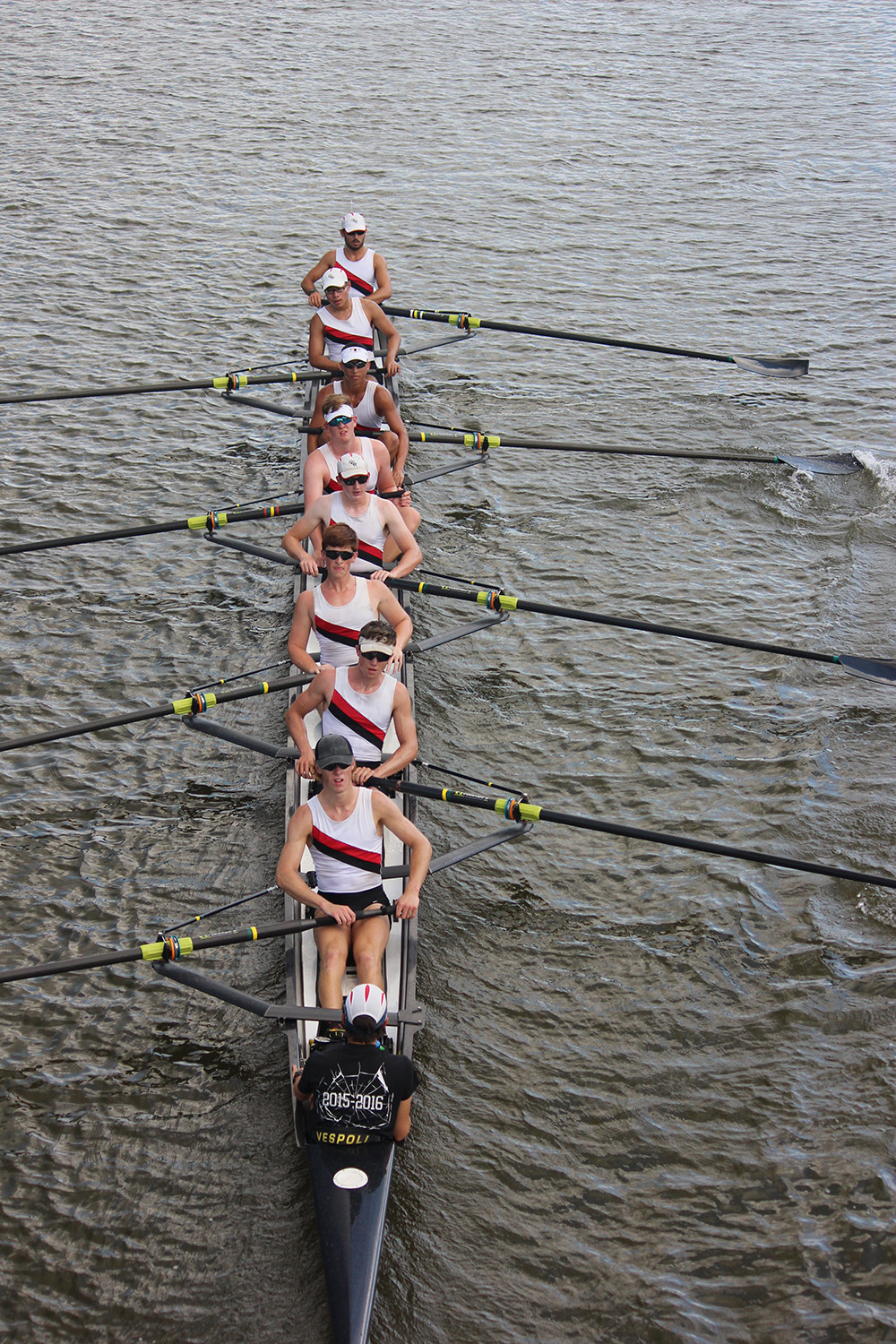
2017 state championships in Sarasota, Florida.
Photography: Jennifer Womble
Effort In, Results Out
Take note of the caveat: anybody who is willing to work. As the coaches like to say, what you put in, you get out.
“It takes a lot of time and energy and effort, and you do have to make that commitment personally, and you do have to be responsible to your teammates,” said Gwynn-Shapiro. “But you get all of that back and more.”
In addition to rowing on Lake Hall three times a week, CCR rowers head the other three practice days to an unprepossessing structure next to the Forestmeadows Athletic Center known as the erg shack. To build up fitness, strength and endurance, they condition there on ergometers, or rowing machines. With fans churning, music blaring and coaches shouting encouragement, rowers push themselves to outdo their previous records and climb up in the team rankings. They are tough, at times grueling workouts.
“That’s not any rower’s favorite place to be,” said Ding. “Everyone has experienced blood, sweat and tears in that one little, tiny shack.”
As a siesta-loving novice, Ding struggled in that stuffy, stinky space, never seeming to get any faster.
“Sometimes you think, ‘I’m doing everything I can, yet I’m still the slowest here,’” she said. “It took a lot of building up my mental stability to realize that, as long as I kept putting in the work, it’s going to go somewhere.”
And that’s pretty much what happened. During winter break her sophomore year, Ding showed up to every optional workout. By the start of the spring season, her much-improved erg scores catapulted her into the top boat. By the end of this, her last, season, she was in the lightweight four headed to nationals.
It Takes a Team
On the ergs as on the water, rowers push to improve. But in addition to pushing as individuals, they have to push as part of their crew. Individual rowers don’t win races: Boats win races.
As a rower, you are at once critical and dispensable to your boat. Dispensable in that, should a stronger rower come along, you might get bumped to a lower boat. Part of a rower’s motivation for working hard is to retain his or her spot. But once seated in a boat, she or he is indispensable. Each rower is like a bulb in an old-school string of Christmas lights: If one light goes, the whole string goes with it.
In most other sports, one breakdown won’t trigger a team-wide failure. A dropped fly ball won’t incapacitate the other outfielders. The whole team doesn’t accompany a fouled-out basketball player to the bench.
In rowing, however, a mistake or weakness can reverberate down the line of rowers, sometimes bringing a racing boat to a sudden halt. A sick rower can be subbed by another, but the unexpected switch can throw a crew for a loop.
Although the success of a boat depends in part on the individual talents or strengths of its rowers, it hinges more on their ability to work together.
Coach Francis was a swimmer and tennis player before trying CCR as a high school freshman. What made the new sport click for him?
“I never really felt that invested in something like that before,” he said. “Committing to something bigger than yourself really stuck with me.”
It takes a certain maturity to become a true team member, observed CCR parent Dr. Andrew Wong, who watched first his son then his daughter evolve as rowers. Wong credits the program, in part, to shaping them from children who only had to worry about themselves to young adults living up to their responsibilities toward others.
“They realize how hard they work directly influences the performance of the team,” said Wong. “Because they have to be accountable to their team members, they learn how to make sure they show up on time, put in as much effort as possible during workouts, make sure they do all the things you’re supposed to do as a good teammate.”
Rowers’ responsibilities go beyond moving the boat. They help take care of those boats, which cost tens of thousands of dollars; get to practices and buses on time; represent the team well on the road. No one wants to disappoint their coaches or teammates, said Emily Hoogerheyde, a rower in the top women’s eight and a newly minted Lincoln High School graduate.
“From everything from carrying the boat to the water to bringing it back to the racks, you need those eight girls to do it, and I really like that,” said Hoogerheyde, who is heading to Barry University in the fall on athletic and academic scholarships. “You have people in the boat that you can depend on. When it’s getting too hard, you know they are pushing for you, too.”
The countless hours rowers share in the erg shack, on the water and on the road forge strong ties, said rower Grant Womble.
“Working together that much increases your friendship because you rely on each other all the time,” he said. “So you know them on a different level than if you just knew them from school or something like that.”
Fun Off the Water
The team reaches deep into the lives of many of the rowers. By virtue of shared schedules, goals and experiences, fast friendships form. They cram for tests at cafés, support each other through personal crises, attend one another’s concerts, carbo-load at boat dinners. At regattas, between races, rowers sprawl in the shade of CCR tents in their red, black and white spandex unisuits, killing time with stories, jokes, laments.
Occasionally, they converge en masse: On prom night last April, several dozen rowers convened at one home in gowns and tuxes for photos before the big dance. The designs of the girls’ dresses—spaghetti straps, strapless, backless—were as varied as the tan line patterns on their exposed shoulders.
Behind the scenes, parents become friends too, bonding over cooking, chaperoning, chauffeuring, board meetings and the hours of waiting under hot regatta tents for the few minutes parents will actually see their child speed by on the water. Prom night was no different: After the students shipped off, parents had their own party. At one point, a karaoke machine materialized. Taking advantage of their children’s absence to act in ways that would have mortified their spawn, several parents seized the mic, belting out hits from their own youth.
Relationships built in good times help the group weather the bad, as happened at one low point two years ago when Clint Farley, father of rower Marcus, passed away suddenly. CCR parent Kathy Bartlett remembers how the team rallied around Marcus at the time.
“Those guys were so there for him,” Bartlett recalled. “I think his dad died on a Monday, and on Tuesday afternoon Marcus was on the water. He said, ‘I just need to be with my friends, and I need to be on the water.’ I think that just says so much about just the whole program.”
Lessons for Life on Land
CCR teaches kids the fine points of rowing. But when it comes to lessons learned in the program, parents and rowers alike talk as much about life skills as finessing an oar.
“The stuff that is getting them success within our program is also getting them success elsewhere,” Tillotson said.
First, there’s the core value of discipline. Don’t feel like coming to practice? Not willing to pull as hard as your fellow rowers? That won’t cut it in rowing: Discipline is non-negotiable. And as it becomes ingrained at practice, it rubs off in school, too. Most rowers couldn’t leave their competitive spirits at the classroom door even if they tried, and they egg each other on there as they do on the water.
“They motivate you to do better academically,” said coxswain Jake Hershberger. “It gives you a drive. If you start slacking on school, they’ll say, ‘What’s going on, man? You need to step it up.’”
Seemed to work for Hershberger: The Chiles graduate is heading to LaSalle University this fall on an athletic and academic scholarship.
The ability to balance the demands of rowing and school is predicated on good time management. That’s a life skill that rower/scholar Emily Hoogerheyde, who also shoehorned a part-time job at Trader Joe’s into her schedule last year, has mastered.
“I definitely have learned how to get things done when they need to get done,” she said.
If that sounds stressful … well, rowing can help with that, too. Just ask college-bound coxswain Herschberger. That cox seat, he’ll tell you, is also the hot seat, responsible for keeping the boat safe, steering, race strategy and encouraging the rowers.
“Eight people are always peering at me all the time and listening to everything I say, so it’s a major stress point,” Herschberger said. “But it has also taught me about public speaking and motivation and all these other benefits.”
On top of those social skills, rowing teaches the ability to set feuds aside, move beyond the drama and just get along. Whether you’re stuck in the same boat, erg shack, bus or hotel room, things work a lot better if you do. As Herschberger put it, “If you can’t respect your teammates, it doesn’t work out.”
Of all the skills fostered by the sport, perhaps the most remarkable for a parent to see grow is independence. The coach can’t ride in the boat with you. Moms and dads are back on shore: The water in between might as well be a moat protecting a fortress.
And that’s a good thing, said CCR mom Dr. Yvette Mignon, particularly for teens preparing to strike out on their own.
“We make sure they have plenty of food to eat, but otherwise they’re doing all the work,” Mignon said. “This is their sport and they’re the athletes.”
And when things go well inside that floating fortress, it can be magical.
“In a race,” explained rower Womble, “when we make a move or something, and everyone’s perfectly in sync—even though you’re working really hard and it hurts your legs and your whole body is sore—it just feels almost effortless at the same time, because you’re all working together. You’re moving as one person, pretty much.
“And it feels like … it feels like you’re so intensely focused,” he continued. “And it feels like time almost slows down a little bit, because you’re so focused on what you’re doing. But it also feels like that moment is fleeting, and it will be gone in, like, one second. It’s kind of a weird phenomenon.”
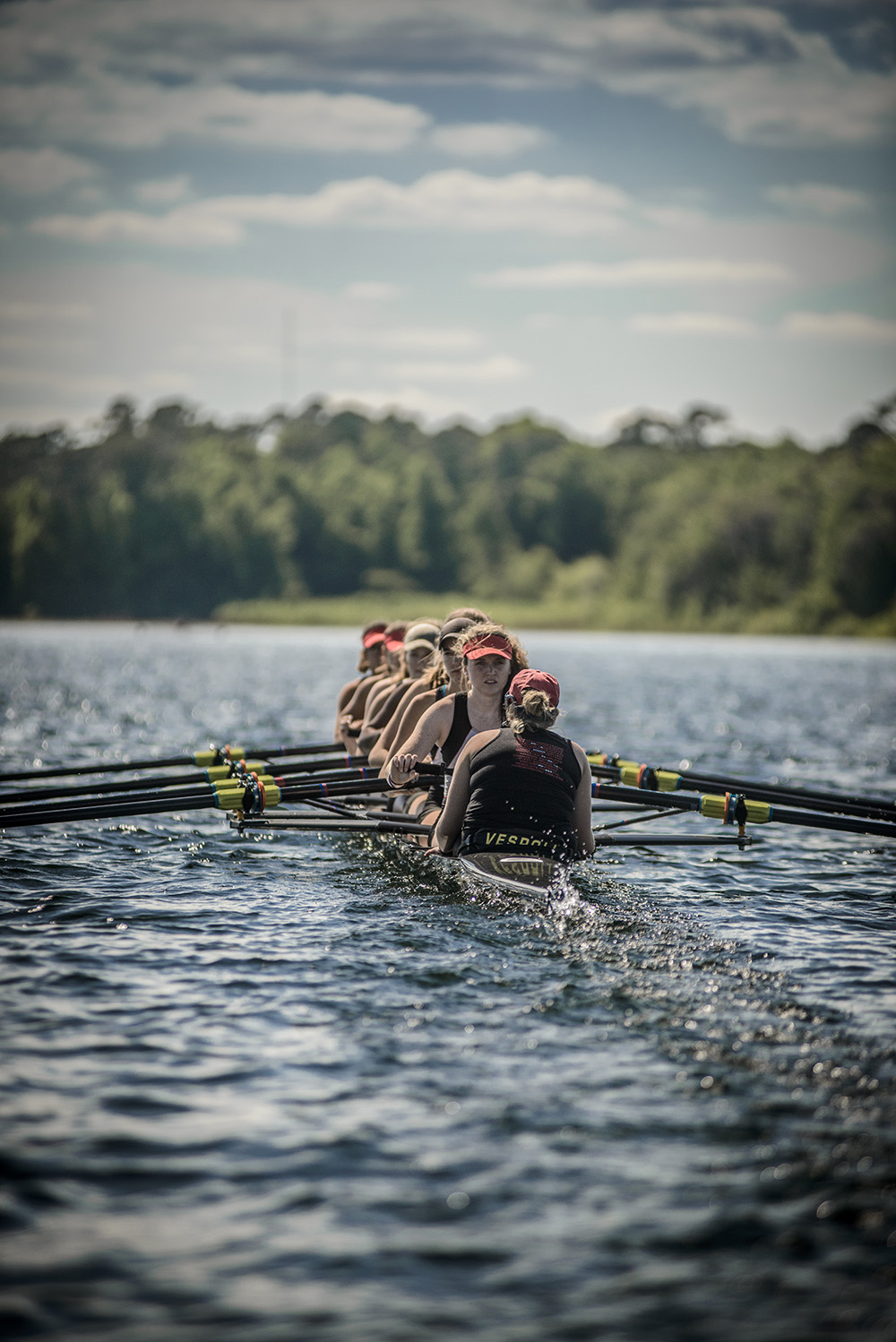
Race Day
Sarasota’s Nathan Benderson Park, home to a worldclass rowing facility, hosted this year’s US Rowing Youth National Championships. Throughout that second weekend in June, the park was packed with fans and elite athletes from rowing powerhouses across the nation. There was Saugatuck from Connecticut, CRI from Boston and the Chicago Rowing Foundation—programs that dwarfed CCR. CRI had a multimillion-dollar budget; Chicago used a boathouse boasting a zinc and slate exterior and indoor rowing tank; storied Saugy had earned spots for 10 boats in the competition.
CCR brought two.
This was not CCR’s first appearance at nationals. The club has earned bids every year since 2008, and last year the men’s four took fifth place. But this year the women shone, and their eight and lightweight four were in Sarasota to face their stiffest competition ever.
The competition began Friday with time trials for each rowing class, one boat following another down the course in a race against the clock. Each boat’s placement in those trials determined the bracket in which it would later compete. The fastest boats would advance to the A finals to battle it out for the gold, silver and bronze medals. Progressively slower boats were sent on to the B, C and D finals.
In a regatta, there are different ways to measure success. For some, it’s nothing less than a solid win, with your boat’s bow passing that finish line first, preferably with open water in its wake. For others, it’s walking away with a medal. A boat that fails to medal yet rows its fastest time ever has certainly achieved something, too. Surpassing expectations —whether your own or others’ — is another kind of victory. Maybe you beat a longtime rival, come back from behind, recoup from a mistake, or just have a damn good row — painful yet effortless, everyone in sync. In each of these feats lies a measure of victory.
Between her son and daughter, CCR parent Carrie Stolp has watched a lot of races. Her favorite win dates back several years; her son, Connor, heading to Rollins College this fall to row, was toward the end of his first season. He and the other boys in his eight were out ahead in their heat, looking poised to win a spot in the finals. Then suddenly, a rower’s worst nightmare: One of the boys mistimed his stroke, causing the shell to skid to a standstill.
For many boats, especially one so inexperienced, that would have been the end: Nine dispirited boys resigned to defeat as their competitors flew by. But these boys, led by their coxswain and drawing on their training, discipline and commitment to one another, quickly regained their composure, restarted their race, and rowed their hearts out, in the end gaining their spot in the finals.
“They knew they could, they knew they had the ability,” said Stolp. “And they just did it.”
What regatta was that? And who ended up rowing away with the gold? Stolp neither remembers nor cares. In her book, those boys won. They defeated fear, embarrassment, and failure itself, and they did it with open water.
That’s one vision of a great race. This is head coach Tillotson’s: “You want to get on out, just become so comfortable and confident in yourself and your teammates that you can go out and dictate the terms of how things are going to go over the next 2,000 meters to everyone else who is out on the water. The rowers are not responding. They’re the ones out there setting the terms.”
Tillotson witnessed that vision earlier in the spring season, when the women’s top eight boat, for the first time, bested a field of a dozen crews at the Florida Sprints League Championship. It was a big win, worthy of a coxswain dunking, and netted each victor a drawerful of t-shirts.
During nationals weekend in Sarasota, CCR women claimed several kinds of victories. In Friday’s time trials, the eight finished 14th of 23 crews, two spots away from a chance at the A Finals. But the row felt good, and they beat longtime rival Atlanta, who had edged them out for second at regionals. After rowing in their C Final on Saturday, they ended the competition 17th in the nation: CCR’s women’s eight had never rowed so well.
The lightweights finished 19th in their Friday time trials, landing them at the top of the D Finals bracket, scheduled the following afternoon. Until that time, each rower’s biggest challenge would be staying within the class’s 130-pound maximum weight. One of them had already sacrificed several inches of her thick, brunette tresses to the cause, giving new meaning to the term “crew cut.” The rowers were reportedly beset by ”hanger,” clinging to the promise of post-race donuts.
Cruelly, lightning storms brought competition to an early halt Saturday, postponing their race to Sunday afternoon. Saturday night, while the women’s eight celebrated their season with pasta and ice cream, the lightweights stayed behind, settling for salads.
Eventually, though, their race time arrived, and, with the flash of the green start light, CCR and its three competitors were off. It was the third to last race of the weekend; the big battles were over, medals and trophies had been doled out, the crowds had thinned. But by the finish line, a rowdy group of spectators wearing red, black and white awaited their hangry rowers. There were parents, grandparents, siblings; the rowers from the women’s eight; and a contingent of CCR men who had made the drive down to root their teammates on.
From their spot near finish line, only the last 500 meters of the course were in view. But thanks to the jumbotron overhead, they could watch the race from the first strokes.
And this is what they saw: A crew who had just become so comfortable and confident in themselves and their teammates that it went out and dictated the terms of how things would go over the next 2,000 meters to everyone else who was out on the water. They did not respond to the other crews. They were the ones out there setting the terms.
As they dominated the water in their sprint to the finish, their fans dominated the shore. “CCR! CCR!” they yelled in unison, drowning out everyone else. The chant turned into a cheer as CCR crossed the finish line, a boat length of open water between its stern and the nearest rival.
There were no medals waiting for the rowers on shore: That honor is reserved for the top three boats in each class, and they had finished 19th overall. But there were serenades from their teammates, bear hugs from their families and the knowledge that they had absolutely owned that race, seizing the lead from the start and never letting go. Perhaps most welcome, however, was the box of calorie- laden, sugar-sodden, delightfully decadent donuts.
It was a fitting end to the best women’s season in CCR history. For several of the athletes, it was also the end of their high school rowing careers. For rising senior Laura Reeves, who rowed in the first, or stroke, seat in the eight, it was the end of the best 10 months of her life.
“From every aspect—from racing to hanging out together in the hotel room to our pep talks before we come here—it’s just been a great experience,” she said. “We all feel amazing about how it ended.”
She was also excited about how the next season would begin: She and six of her boat mates from nationals would be returning to CCR in the fall.
“We’re all ready to do more damage next year,” said Reeves. “We’re going to come back stronger than ever before.”

